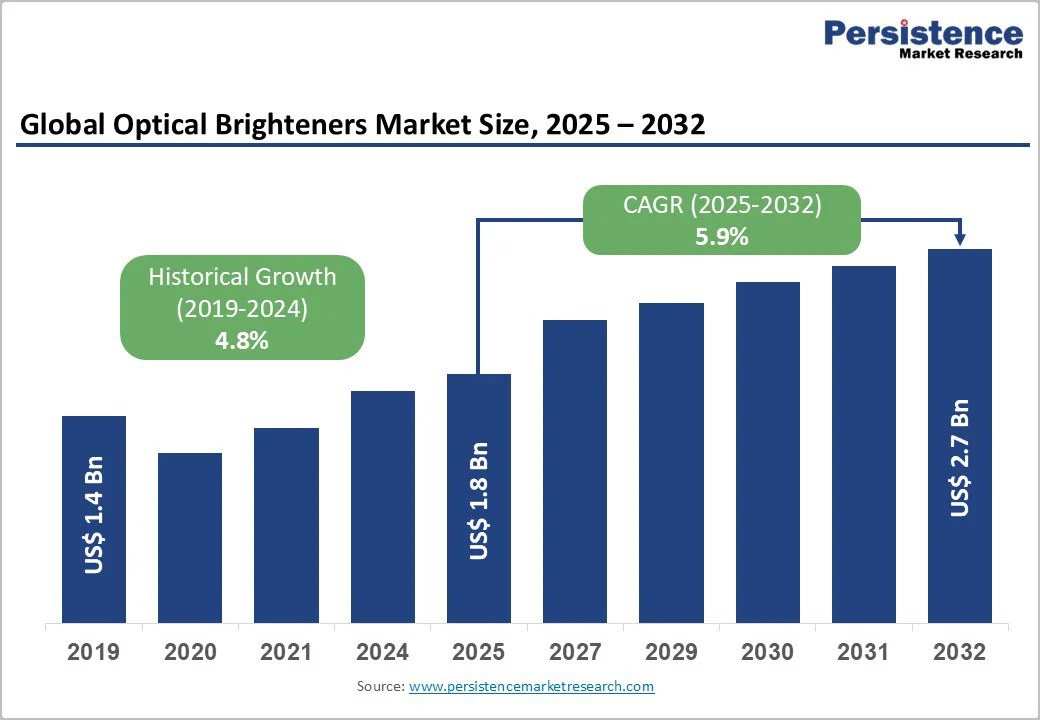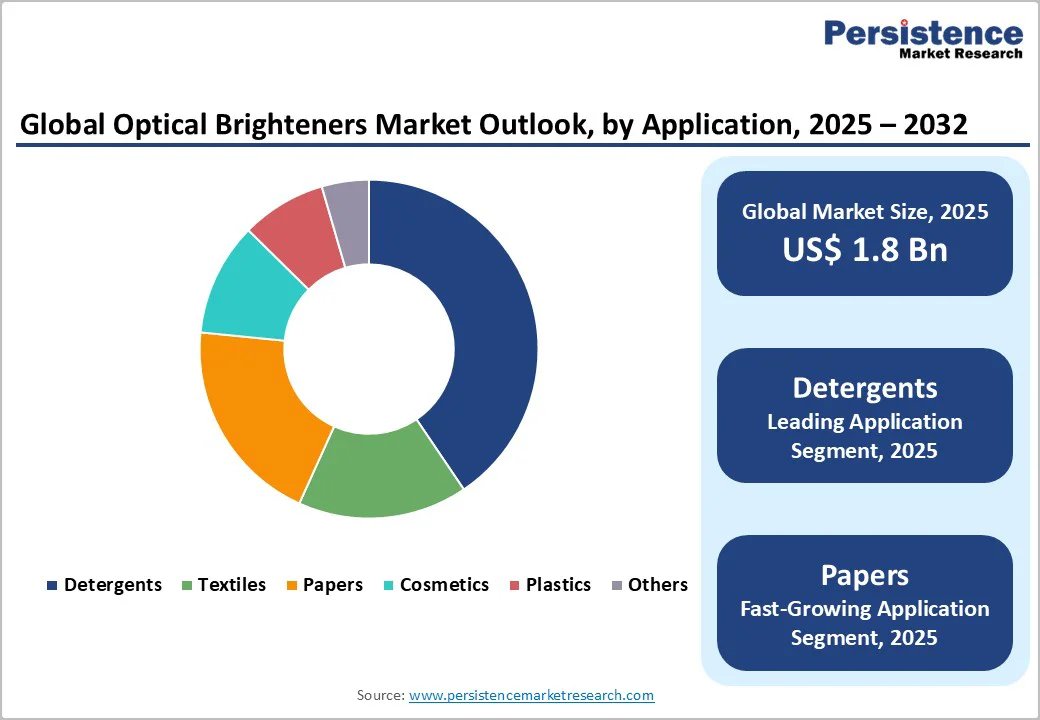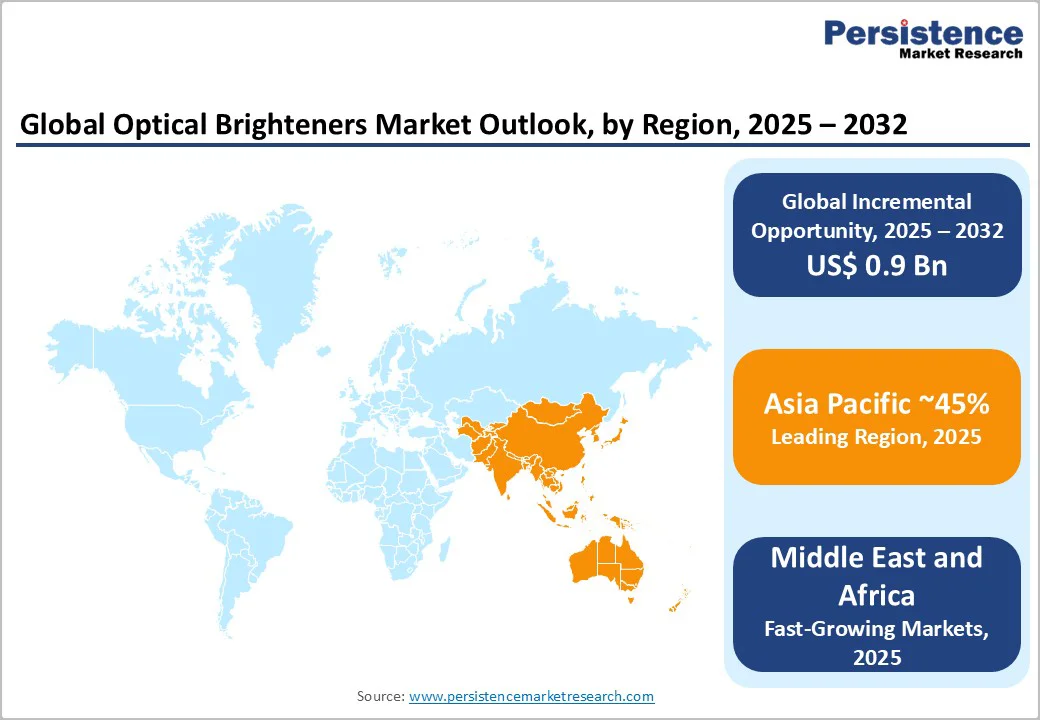ID: PMRREP32029| 196 Pages | 28 Oct 2025 | Format: PDF, Excel, PPT* | Chemicals and Materials

The global optical brighteners market size is likely to value at US$ 1.8 Bn in 2025 and is projected to reach US$ 2.7 Bn by 2032, growing at a CAGR of 5.9% between 2025 and 2032.
This growth is driven by expanding applications in the textile and detergent industries, where optical brightening agents enhance product visual appeal by converting ultraviolet light into visible blue light. Additionally, increasing consumer demand for aesthetically superior products across packaging, cosmetics, and paper sectors continues to boost market expansion.
| Key Insights | Details |
|---|---|
|
Optical Brighteners Market Size (2025E) |
US$1.8 Bn |
|
Market Value Forecast (2032F) |
US$2.7 Bn |
|
Projected Growth CAGR (2025-2032) |
5.9% |
|
Historical Market Growth (2019-2024) |
4.8% |

Rising Demand from Textile and Apparel Industries Propels Market Growth
The textile and apparel sector continues to drive robust demand for optical brighteners, as manufacturers focus on enhancing fabric whiteness, brightness, and visual appeal. Optical brighteners are widely used during bleaching, finishing, and dyeing processes to improve color vibrancy and fabric aesthetics. The increasing emphasis on sustainable and energy-efficient textile production has encouraged the adoption of advanced brighteners that maintain performance even at lower processing temperatures.
Archroma launched ULTRAPHOR® concentrated optical brighteners, designed to deliver high whiteness while reducing water and energy usage in textile and detergent applications. This innovation exemplifies the industry’s push toward eco-friendly, high-performance brightening agents, enabling manufacturers to achieve superior fabric brilliance with reduced environmental impact.
Growing Paper and Packaging Industry Applications Drive Market Expansion
Optical brighteners are increasingly adopted in the paper and packaging sector to achieve enhanced whiteness and brightness, which is essential for premium printing and packaging materials. Their use in pulp processing, surface coatings, and finishing ensures a superior visual appearance and print quality, which are crucial for brand perception and consumer appeal. The rise of e-commerce and packaged consumer goods has further intensified the demand for visually appealing paper products.
Industry players are responding by introducing innovative, environmentally compliant optical brighteners tailored for paper applications. These advancements enhance brightness in recycled and coated paper while aligning with sustainability standards, reflecting the sector’s dual focus on performance and eco-friendliness.
Environmental Concerns and Regulatory Restrictions Hinder Market Growth
Environmental sustainability concerns remain a major restraint for the optical brighteners market, as many conventional agents are not readily biodegradable and can persist in wastewater, negatively affecting aquatic ecosystems. To address this challenge, leading chemical companies like Archroma have launched eco-friendly, formaldehyde-free optical brighteners designed for safer disposal and improved biodegradability, helping manufacturers comply with stringent environmental standards.
Despite these innovations, regulations such as EPA guidelines and EU REACH requirements continue to impose compliance costs and operational challenges. Smaller manufacturers face difficulties adopting greener formulations due to high R&D investment, while all players must balance regulatory compliance with maintaining performance and cost efficiency, thereby slowing market expansion.
Raw Material Price Volatility Impacts Production Economics
Fluctuations in raw material prices remain a significant hurdle for optical brightener manufacturers, as key chemical intermediates are influenced by geopolitical factors, import-export restrictions, and environmental regulations. Sudden cost spikes increase production expenses and impact profit margins, particularly for mid-sized and smaller players with less supply-chain flexibility.
The technical complexity of reformulating optical brighteners with greener or more sustainable alternatives creates extra R&D burdens. Manufacturers must invest in developing new compounds that maintain brightness performance while minimizing environmental impact, which can limit their ability to offer competitive pricing in global markets.
Development of Eco-Friendly and Bio-Based Optical Brighteners
Sustainability is creating a key opportunity for optical brightener manufacturers to develop eco-friendly, bio-based, and formaldehyde-free compounds. Companies that innovate in high-performance yet environmentally compliant brighteners gain a competitive edge. A notable example is Archroma’s Leucophor® AP, a biodegradable, formaldehyde-free optical brightener meeting OECD 301 standards, delivering excellent whiteness while minimizing environmental impact.
The push for greener production is encouraging the development of rapidly biodegradable OBAs that maintain performance in textiles, detergents, and paper. Manufacturers can leverage this trend to integrate sustainability without compromising brightness, stability, or compatibility, opening adoption opportunities across diverse end-use sectors.
Expansion in Emerging Markets and New Application Segments
Emerging markets in Asia, Africa, and Latin America offer strong growth potential due to industrial expansion and rising demand for textiles, detergents, and packaging. Regions like the Middle East & Africa are seeing accelerated adoption from urbanization and enhanced manufacturing capacity.
New application areas are also driving demand, including security printing, anti-counterfeiting, and high-temperature polymer processing using thermally stable diphenylpyrazoline-based brighteners. The rise of e-commerce and premium packaging further expands revenue opportunities in visually appealing paper and polymer products.
Stilbene derivatives continue to dominate the market due to their excellent whitening properties, chemical resistance, and stability across multiple applications. They are widely used in textiles, detergents, and paper, where permanent brightening and high thermal tolerance are critical. A notable example is BASF’s expansion of Tinopal® CBS production at Monthey, Switzerland, reflecting the growing global demand for high-performance stilbene OBAs across industrial and household applications.
Benzoxazole derivatives are emerging as the fastest-growing segment, particularly in plastics and high-temperature polymer applications. Their superior thermal stability and UV resistance make them ideal for extrusion, molded parts, and specialty coatings. Companies such as Clariant have recently introduced advanced benzoxazole OBAs designed for polymer clarity and color retention, capturing new growth opportunities in packaging, automotive, and engineering plastics.
The detergent segment leads the market, using optical brighteners such as distyryl biphenyl (DSBP) and anionic diamino stilbene to maintain fabric brightness and cleanliness. These brighteners outperform traditional bluing agents in laundry powders, dishwashing liquids, and household cleaners. For instance, Clariant’s high-solubility stilbene OBAs enable low-dosage use in liquid detergents while ensuring superior whiteness, reinforcing the segment’s market dominance.
Paper and packaging applications are the fastest-growing segment, driven by rising demand for visually appealing packaging and premium printing materials. Innovations like Archroma’s Leucophor® AFCN, a formaldehyde-free brightener for coated paper and food packaging, showcase the sector’s focus on environmental compliance alongside high performance. E-commerce growth and brand packaging requirements further accelerate the adoption of optical brighteners in paper products worldwide.

North America holds a significant share in the optical brighteners market, supported by well-established textile, paper, and detergent industries that require high-performance brightening agents. The region focuses on product quality, operational efficiency, and strict compliance with chemical regulations, ensuring consistent adoption across industrial and consumer applications. Huntsman Corporation, headquartered in The Woodlands, Texas, produces optical brightening agents under the Huntsman OBAs brand, catering to detergents, textiles, and paper with advanced, reliable formulations.
The market also emphasizes sustainability and eco-friendly solutions, with manufacturers investing in research, supply chain optimization, and environmentally compliant brighteners to maintain regulatory adherence. Rising consumer demand for vibrant textiles, premium paper, and effective laundry outcomes further stimulates growth, while continuous innovation in brightening agents supports industrial competitiveness. The combination of mature infrastructure and technological advancement ensures steady expansion across North America.
Europe’s optical brighteners market benefits from established textile, detergent, and paper industries, underpinned by stringent environmental and industrial regulations. Leading manufacturers like BASF SE, headquartered in Ludwigshafen, Germany, produce Tinopal® and Lumalite® OBAs that combine high performance with eco-compliance, addressing regional sustainability priorities while ensuring consistent brightness in textiles, detergents, and paper products.
The region focuses heavily on innovation, quality, and regulatory compliance, with investments in R&D and advanced chemical formulations driving adoption across industrial and consumer applications. Consumer preference for visually appealing textiles, premium-quality paper, and effective cleaning products reinforces market growth. Continuous improvements in sustainable brighteners, coupled with advanced manufacturing processes, position Europe as a steady, innovation-driven market in the global optical brighteners landscape.
Asia Pacific dominates the global optical brighteners market, driven by rapid industrialization, cost-effective manufacturing, and the expansion of the textile, detergent, and paper sectors. China, India, and Indonesia lead production and export, supplying both domestic and international markets, including the United States, Australia, and Bangladesh. The region benefits from access to raw materials and skilled labor, supporting large-scale production and competitive pricing.
Rising domestic consumption, expanding e-commerce packaging, and growing awareness of premium-quality finished products further drive adoption. Investments in modern chemical facilities, textile hubs, and process optimization enhance production efficiency and product performance. Strong government support, coupled with industrial expansion in textile and detergent hubs, solidifies Asia Pacific as the largest and most dynamic contributor to the global optical brighteners market.

The optical brighteners market exhibits a moderately consolidated structure, with leading players maintaining advantages through diverse product portfolios, advanced manufacturing capabilities, and strong customer relationships across multiple end-use industries. Competition is largely driven by product performance, technical support, and innovation in high-quality formulations.
Significant investments in research and development are focused on sustainable, environmentally compliant optical brighteners that meet evolving regulatory standards while delivering superior whitening performance. Strategic collaborations with downstream manufacturers, as well as expansion into emerging markets, remain key growth strategies, enabling companies to strengthen market presence and address increasing demand across textiles, detergents, paper, and specialty applications.
The global optical brighteners market was valued at US$ 1.8 Bn in 2025 and is projected to reach US$ 2.7 Bn by 2032, growing at a CAGR of 5.9% during the forecast period.
The key demand drivers include expanding textile and apparel industries, growing paper and packaging applications, increasing consumer preference for aesthetically appealing products, and rising demand from detergent manufacturers for enhanced fabric brightening solutions.
Stilbene-based optical brighteners hold the leading market position with approximately 46% market share due to their superior whitening properties, excellent stability, and compatibility across diverse industrial applications.
Asia Pacific dominates the global market with 61% market share in 2025, driven by robust manufacturing activities in China, India, and other regional economies, particularly in the textile, paper, and detergent industries.
The development of eco-friendly and bio-based optical brighteners represents the most significant market opportunity, as environmental sustainability becomes a procurement priority for industries and regulatory compliance requirements intensify globally.
Key market players include BASF SE, Huntsman Corporation, Clariant AG, Eastman Chemical Company, Archroma, Milliken and Company, and regional manufacturers such as Meghmani Organics Ltd and Brilliant Group.
| Report Attribute | Details |
|---|---|
|
Historical Data/Actuals |
2019 - 2024 |
|
Forecast Period |
2025 - 2032 |
|
Market Analysis |
Value: US$ Mn/Bn, Volume: As Applicable |
|
Geographical Coverage |
|
|
Segmental Coverage |
|
|
Competitive Analysis |
|
|
Report Highlights |
|
By Product Type
By Application
By Region
Delivery Timelines
For more information on this report and its delivery timelines please get in touch with our sales team.
About Author